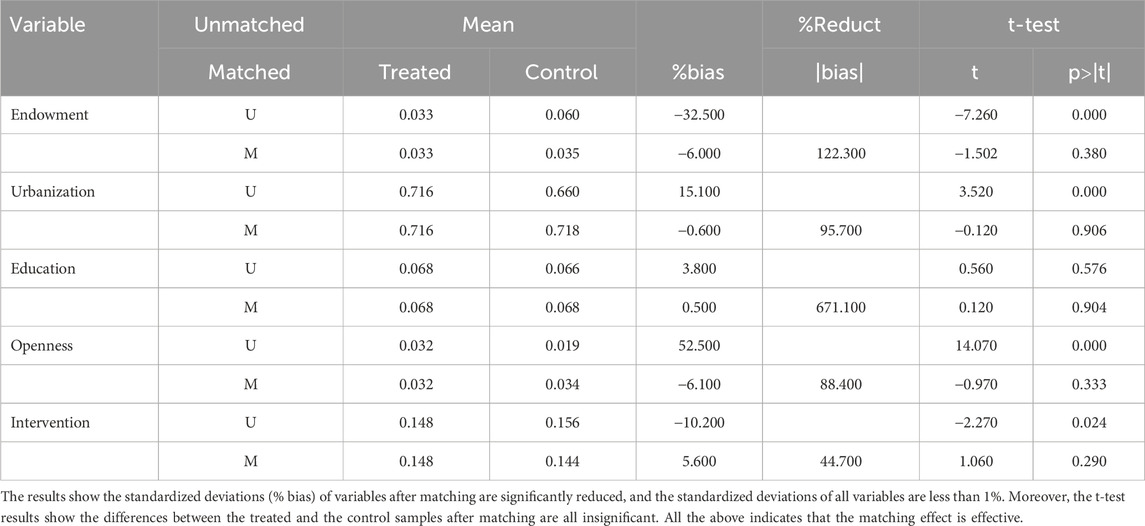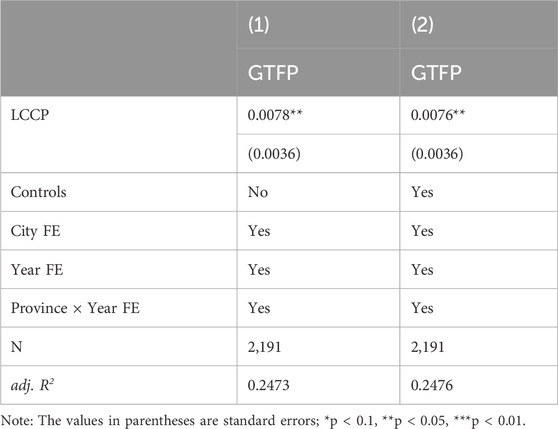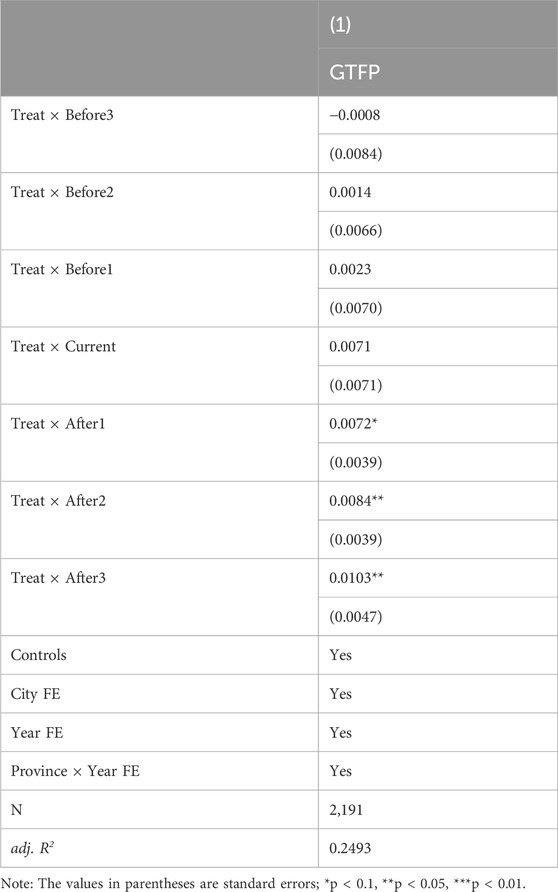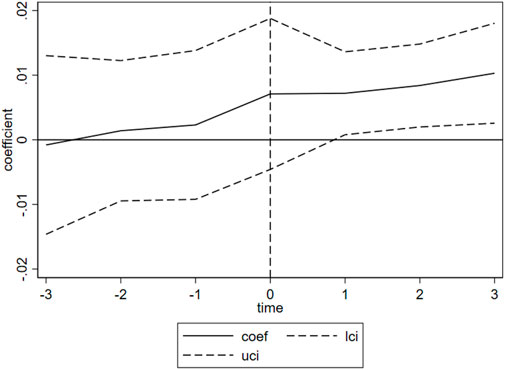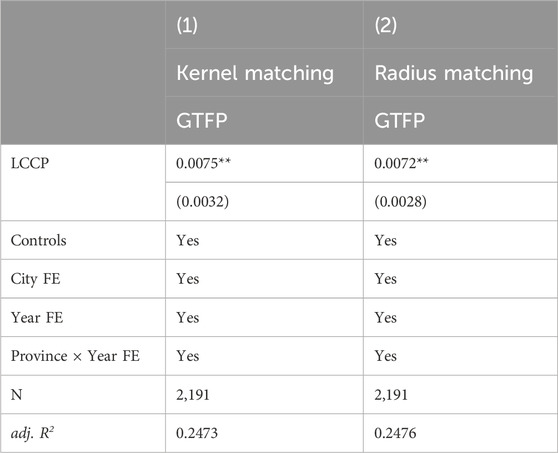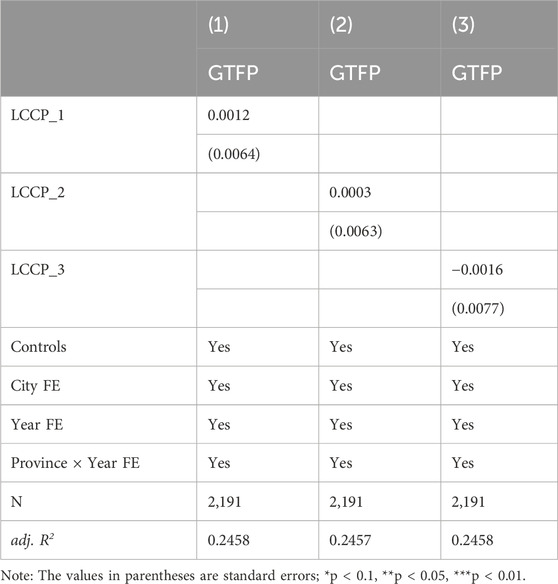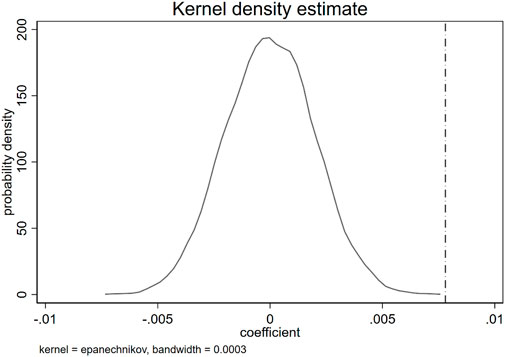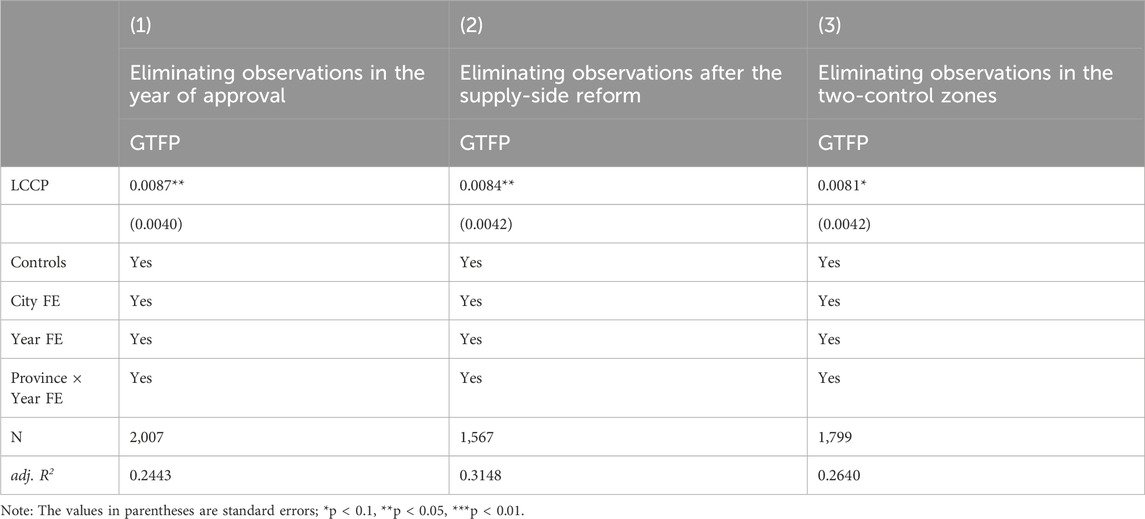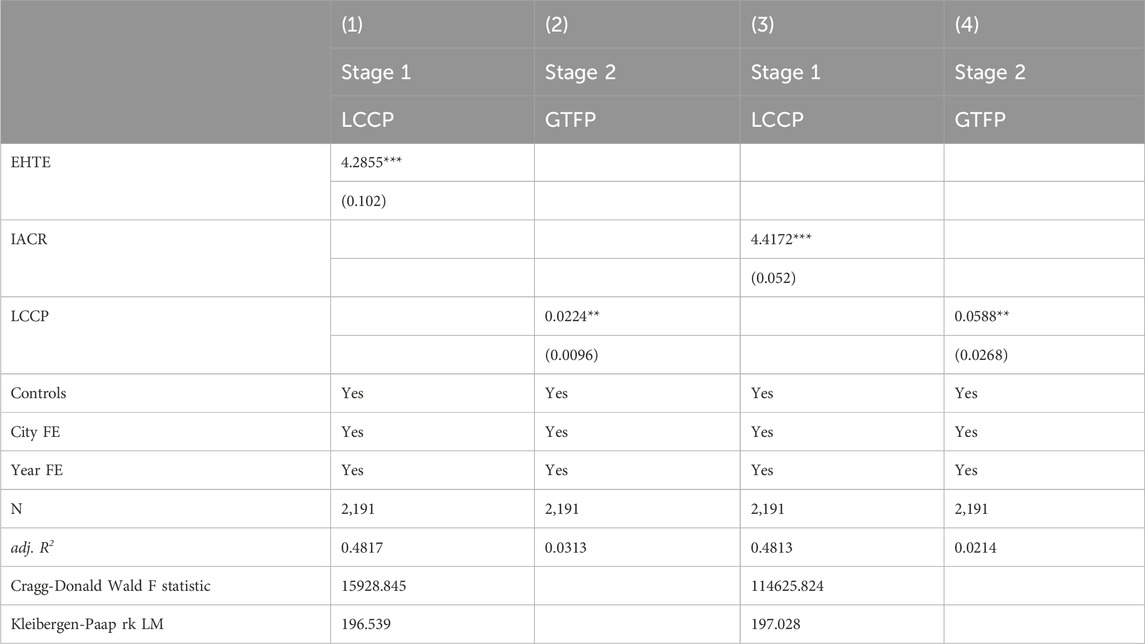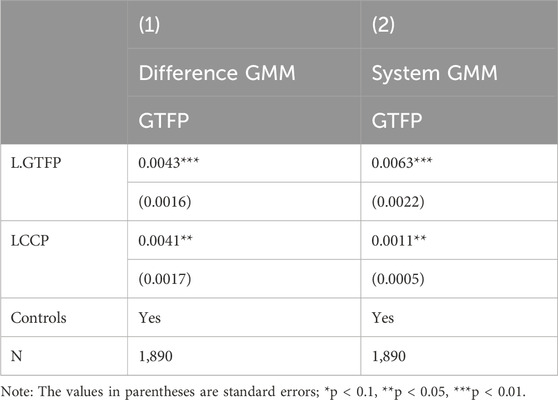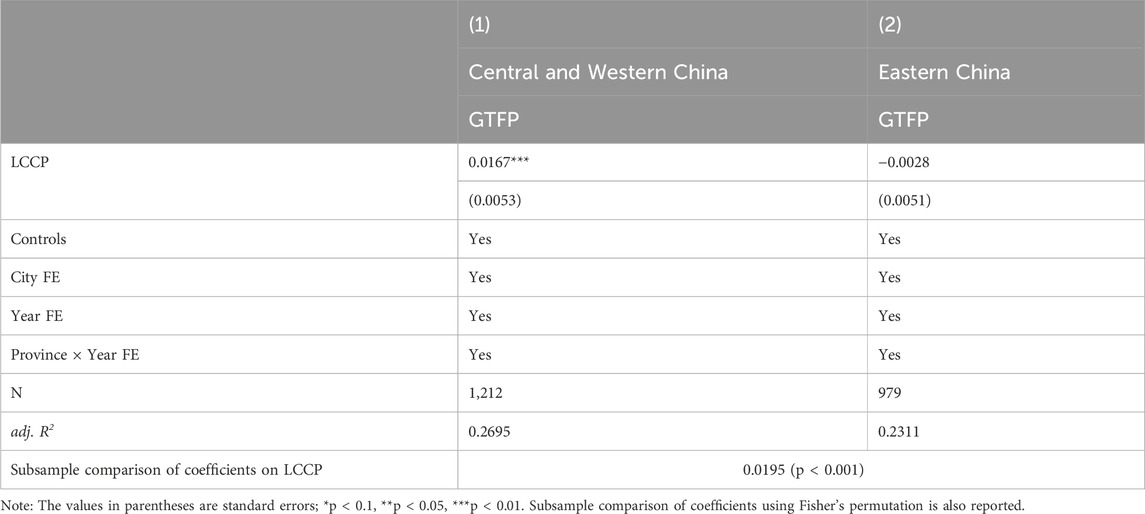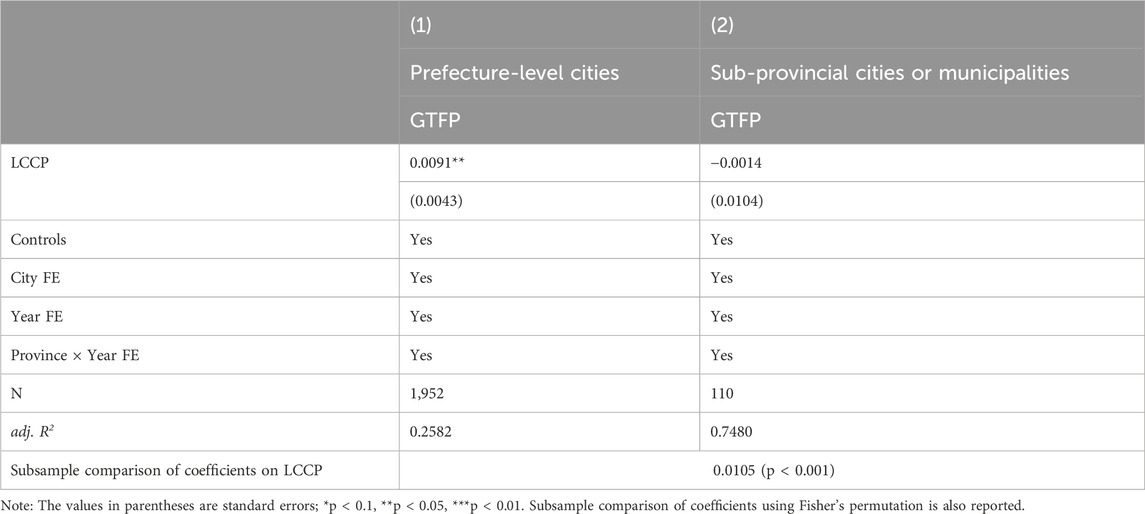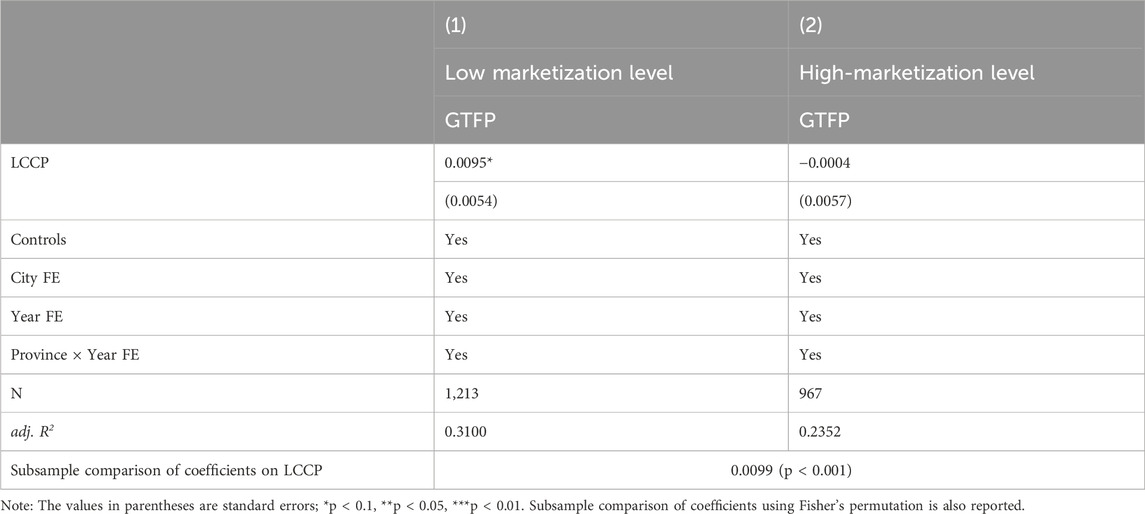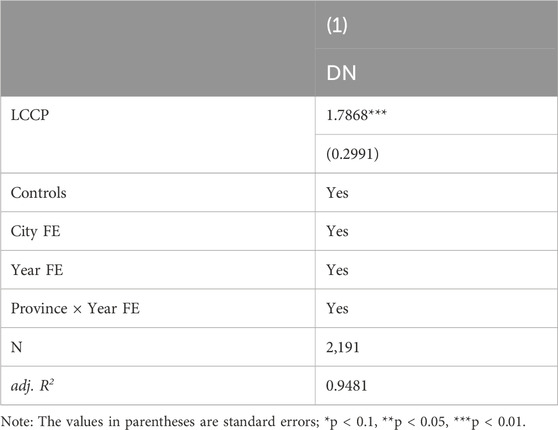- 1SILC Business School, Shanghai University, Shanghai, China
- 2Department of Chinese Language and Literature, East China Normal University, Shanghai, China
Utilizing a panel dataset of 273 prefecture-level cities in China from 2000 to 2019, this study evaluates the impact of the low-carbon city pilot (LCCP) policy on green total factor productivity (GTFP). This study calculates GTFP via a hybrid function model of the epsilon-based measure. Using a staggered difference-in-differences framework, we found that the LCCP policy improves GTFP. Through its implementation, the LCCP policy exerts an increasingly positive impact. We identify promoting industrial structure optimization and technological innovation as two plausible underlying mechanisms. Heterogeneity analysis finds that the impact is more pronounced in central and western China, as well as in low-level administrative and low-marketization cities. This study provides empirical evidence for the optimization of the LCCP policy and the transformation of the low-carbon economy, and provides a basis for policy-making.
1 Introduction
The accelerated growth of the global economy has intensified the conflict between industrialization and ecological balance, with anthropogenic CO2 emissions driving irreversible climate change. Specifically, in the 21st century, the massive energy consumption and consequent excessive CO2 emissions have become issues of great concern worldwide. According to the US Energy Information Administration, the global CO2 emissions have continued to increase since 2000. Although total carbon emissions stabilized from 2013 to 2016, this figure continued to rise from 2017 onward, approaching 40 billion tons. By the end of this millennium, the quasi-equilibrium amount of CO2 in the atmosphere is estimated to increase by 40% relative to the pre-industrial peak concentration (Solomon et al., 2009). Global efforts to mitigate this crisis vary significantly: the European Union has prioritized carbon pricing mechanisms like the Emissions Trading System (Dechezleprêtre et al., 2023), while the US Inflation Reduction Act (2022) emphasizes renewable energy subsidies and tax incentives (United States Environmental Protection Agency, 2025). Developing regions such as Africa face paradoxical outcomes, where agricultural advancements risk increasing deforestation and emissions due to market integration dynamics (China Meteorological Administration, 2014). Against this backdrop, China’s low-carbon city pilot (LCCP) policy, initiated in 2010 across three batches of cities, stands out as a systemic experiment integrating spatial governance, industrial restructuring, and innovation-driven decarbonization. Unlike fragmented regional policies elsewhere, this initiative exemplifies China’s unique role in bridging large-scale climate governance with localized economic transformation, offering a model for emerging economies.
As the world’s second-largest economy, largest energy importer and exporter, and most populous country, China faces a severe carbon emissions challenge. According to the Environmental Performance Index report released in 2020, China ranks 120th among 180 countries (Hao et al., 2020). China’s carbon intensity remains 60% higher than the global average, with recent studies highlighting persistent challenges in balancing industrial growth and emissions control (Wang et al., 2022). For instance, centralized environmental inspections have reduced regional emissions by 12%–15% but face implementation gaps in high-energy-consuming sectors (Wang et al., 2022). Based on the current national conditions, a 1% increase in China’s economic scale would induce a sharp rise of approximately 15 metric tonnes in its average annual carbon emissions (Tu, 2014). Undoubtedly, increasing CO2 emissions is universally considered an inevitable by-product of China’s economic growth. For instance, a high dependence on exports and processing the trade of low-value-added products results in high energy consumption and carbon emissions per GDP unit. However, in the medium-to-long term, rapid urbanization and modernization will generate more middle-income people with energy- and carbon-intensive lifestyles (Qi et al., 2013).
The necessity of this study is further underscored by China’s evolving carbon governance framework. Recent analyses of carbon markets reveal that trading mechanisms reduce corporate emissions by 8%–12% but struggle to incentivize productivity gains in state-owned enterprises (BIT Center for Energy and Environmental Policy Research, 2025). Concurrently, biomass burning, responsible for 1.21 billion tonnes of annual carbon emissions from savanna fires alone, remains underregulated, complicating emission inventories (People’s Daily, 2024). These challenges highlight the urgency of evaluating the LCCP policy through a green total factor productivity (GTFP) lens, which integrates environmental and economic performance. By employing a quasi-natural experimental design, this study addresses the dual deficiency in prior literature: (1) the lack of systemic assessment of how the pilot policy drives quality-oriented growth beyond mere emission cuts (Zhu et al., 2013), and (2) the need for spatially differentiated strategies to optimize decarbonization in resource-dependent versus innovation-led cities (Wang et al., 2022; Zeng et al., 2023).
To this end, this study examines the effect of the LCCP policy on GTFP by analyzing a panel dataset spanning 273 prefecture-level cities from 2000 to 2019. GTFP is measured using a hybrid epsilon-based measure (EBM) model. Employing a staggered difference-in-differences (DID) framework, the results reveal that the LCCP policy significantly enhances GTFP, with its positive influence intensifying over time. The primary mechanisms driving this improvement are identified as the promotion of industrial structure optimization and the stimulation of technological innovation. Heterogeneity analysis indicates that the policy’s impact is more substantial in central and western regions, as well as in cities with lower administrative status and lower marketization levels. These findings offer empirical support for refining the LCCP policy and advancing the transition to a low-carbon economy, while providing actionable insights for policymakers.
This study makes the following two contributions to the literature. First, existing studies of the effectiveness of the pilot policy scarcely consider GTFP, mostly focusing on the impact of the pilot policy on carbon emissions as a direct economic consequence. Using the latest EBM method, this study probes how the pilot policy influences urban GTFP, plausible underlying mechanisms of the pilot policy, and related heterogeneity to examine the urban environmental regulation policy comprehensively. Second, using a propensity score matching-difference-in-differences (PSM-DID) model and a series of robustness checks, the study controls model endogeneity effectively to verify the results of the benchmark regression model. Moreover, the EBM for measuring GTFP incorporates a hybrid of the radial and non-radial distance functions, providing a more comprehensive method for evaluating the efficiency of decision-making units. This method partly offsets the deficiencies of traditional data envelopment analysis (DEA) and slacks-based measure (SBM) models.
The remainder of this paper is organized as follows. Section 2 reviews related literature, introduces the LCCP policy’s institutional background, and develops the hypotheses. Section 3 describes the empirical framework, and Section 4 reports the baseline empirical results and robustness checks. Section 5 is devoted to tests on underlying mechanisms, heterogeneity tests, and further economic consequence. Section 6 concludes and discusses policy implications.
2 Related literature and hypothesis development
2.1 Related literature
The existing literature on sustainable development policies and their socioeconomic impacts can be systematically categorized into four key themes: (1) policy effect assessment, (2) industrial restructuring and economic transition, (3) technological innovation and productivity, and (4) regional heterogeneity and spatial dynamics.
A large number of studies evaluate the effectiveness of environmental and energy policies. Zeng et al. (2023) demonstrate that China’s LCCP policy, initiated in 2011, significantly reduced urban carbon intensity through governance improvements, industrial restructuring, and innovation, with notable spatial spillover effects on neighboring cities. Similarly, Zhou et al. (2019) confirm the policy’s sustained and incremental impact on industrial upgrading. However, assessments of policy costs, benefits, and welfare effects remain underexplored. For instance, Song et al. (2019) highlight the balance between corporate emission reductions and industrial upgrading, while Qin et al. (2010) emphasize the need to evaluate comprehensive socioeconomic welfare beyond narrow environmental or economic metrics. Fang et al. (2022) and Fang et al. (2023) extend this discourse by analyzing environmental taxes, revealing nonlinear and time-dependent effects on renewable energy adoption.
Research on industrial restructuring focuses on how policies reshape economic activities. Li (2018) and Zhou et al. (2019) link the LCCP policy to reduced energy intensity and industrial modernization, particularly in non-capital cities. Dong and Li (2020) and Gong et al. (2019) examine regional heterogeneity, showing that foreign direct investment (FDI) and environmental constraints interact differently across cities, with advanced regions benefiting more from industrial upgrading. Zhang et al. (2025) add nuance by identifying an N-shaped relationship between financial development and sustainable economic development in the Yellow River Basin, where excessive informatization may hinder progress.
Green technology innovation and productivity measurement are pivotal mechanisms for achieving sustainability. Zhang et al. (2024a) reveal that China’s new energy demonstration city policy (NEDCP) boosts green patent applications, particularly in energy-saving technologies, by alleviating financing constraints and enhancing market environments. Zhang et al. (2024c) further highlight the role of local government attention in driving GTFP through fiscal decentralization and innovation incentives, with cumulative time-lag effects. Complementing these studies, Guo et al. (2024) advance methodological rigor by proposing the generalized Luenberger productivity indicator (GLPI), which integrates distance elasticity shares into production functions to measure urban GTFP. Using stochastic frontier analysis, they decompose GTFP growth into technological change, technical efficiency change, and scale efficiency change. Their results demonstrate rapid GLPI growth across Chinese cities from 2000 to 2019, validating the feasibility of parametric approaches for productivity decomposition. This methodological contribution enriches the understanding of GTFP drivers, bridging micro-level innovation (e.g., patents) and macro-level productivity trends.
However, innovation outcomes vary by enterprise ownership (Zhong et al., 2020) and policy design. Fang et al. (2023) caution that green tax policies lose efficacy at high innovation levels. A key limitation is the overreliance on patent data as a proxy for innovation, which overlooks non-technological advancements (e.g., organizational or behavioral changes). Guo et al.’s (2024) parametric decomposition addresses this gap by quantifying efficiency and scale effects, offering a more granular lens to evaluate how policies like the NEDCP or fiscal decentralization translate into productivity gains.
Spatial spillovers and regional disparities are critical to policy design. Zeng et al. (2023) and Zhang et al. (2025) confirm strong spatial autocorrelation in sustainable economic development and carbon intensity (Gehrsitz, 2017; Wolff, 2014), where policy effects radiate beyond pilot cities. Zhang et al. (2024b) attribute the success of the NEDCP to localized factors like human capital and fiscal support, while Dong and Li (2020) stress that policy effectiveness diminishes in less-developed regions due to institutional and resource constraints.
2.2 Institutional background
As China’s economic growth enters the new normal (Li and Zhang, 2015), the government has been actively making efforts to carry out a green reform and enhance GTFP, thus establishing a win–win path to environmental protection and economic growth. Since 2010, the National Development and Reform Commission (NDRC) has initiated the LCCP policy at three batches to explore a path to environmental protection and economic growth. Hence, the LCPP policy has garnered significant attention. Cities have always been a major source of greenhouse gas emissions, but they are also the fundamental arena for tackling climate change and implementing the strategies of a low-carbon economy. As early as 2005, the Fifth Plenary Session of the 16th Central Committee of the Communist Party of China resolved to build a “resource-saving and environment-friendly society.” A landmark speech delivered by President Hu Jintao at the 15th APEC Informal Leaders’ Meeting in 2007 heralded the beginning of China’s systematic low-carbon development initiatives. In 2008, Shanghai and Baoding were selected by the World Wildlife Fund for Nature to develop as low-carbon cities. In 2010, the NDRC officially initiated the LCPP policy, suggesting a new “point-to-plane” governance model by the Chinese government. After this first batch, the NDRC successively announced the second and third batches of pilot cities in 2012 and 2017, respectively. Meanwhile, the number of low-carbon pilot cities have increased to 81.
The core of the LCCP policy is to expand the scope of pilot cities sequentially based on their early-stage experiences and enhance the internal impetus for urban innovation and low-carbon development, thus ensuring stable socioeconomic development (Zhuang, 2020). In the current unfavorable situation, such as resource shortage and environmental pollution, GTFP, as the ultimate impetus to China’s economic development (Shu and Kong, 2019), is undoubtedly closely related to the LCPP policy. Therefore, it is imperative to explore the mechanisms underlying GTFP improvement while also considering the important role of the national policy. This approach is a non-negligible part of the effectiveness evaluation of the current environmental policy.
The LCPP policy, being suited to the needs of different development stages and regions, is a key component of China’s climate change governance system, allowing to identify and solve problems and learn from the experience. Through gradual implementation over the past decade, some regions have contributed to the improvement of GTFP by making green innovations, optimizing the industrial structure, and improving resource utilization per local conditions under the encouragement and support of the central government. For example, Hangzhou, a first-batch pilot city, implemented an environment-friendly and low-carbon public bicycle project as a unique action program and a good example for other cities by following the trends of urban development. As the forerunner of the first batch of pilot cities, Shenzhen implemented more than 10 low-carbon demonstration projects, playing a leading role in low-carbon innovation with the joint support of multiple central ministries and commissions (e.g., Ministry of Transport, Ministry of Finance, Ministry of Ecology and Environment, and Ministry of Science and Technology). Zhenjiang, a second-batch pilot city, employed new technologies to develop an intelligent cloud platform for carbon emission management. Moreover, Chengdu, a third-batch pilot city, set a policy orientation for a low-carbon economy via its remarkable efforts (Zhuang, 2020).
From the long-term policy implementation perspective, by considering the complexity of building low-carbon cities, examining the impact of the pilot policy on economic growth and plausible underlying mechanisms has great theoretical and practical significance. Further, it is imperative to empirically evaluate the effectiveness of the pilot policy for the deficiencies encountered in the policy implementation to promote policy innovation in the transformation of China into a low-carbon economy and provide useful evidence and suggestions for subsequent policy adjustments and the implementation of similar policies.
2.3 Hypothesis development
By comparing the two main effects of the pilot policy and given the aims for a win–win situation (i.e., both environmental protection and economic growth), GTFP can be used to examine the impact of the pilot policy on urban GTFP more comprehensively and bridge the gap in the literature on the single effect of the pilot policy. For approved low-carbon pilot cities, preferential policies and industrial support from the central and local governments will directly reduce carbon emissions and based on the development of green technologies and emerging industries, provide a lasting impetus to urban economic sustainability in the new normal, thus improving GTFP. The pilot policy reflects the core design of low-carbon city initiatives, which integrate environmental and economic goals through systemic reforms. GTFP is chosen as the outcome variable because it captures the efficiency of economic output relative to environmental costs (e.g., energy consumption, pollution), making it a holistic metric for assessing the policy’s success in achieving a win-win outcome. Existing literature emphasizes that place-based policies like low-carbon pilots often create direct incentives for cities to adopt green technologies and reallocate resources efficiently, but prior studies have focused narrowly on isolated effects (e.g., carbon reduction or GDP growth). This study bridges this gap, leveraging GTFP to evaluate the policy’s integrated impact. Therefore, this study proposes the following hypothesis:
H1:. The pilot policy improves urban GTFP.
Low-carbon pilot cities have developed green development plans and guidelines suited to their resource endowments, industrial characteristics, and advantages to achieve the greenhouse gas emission reduction target of China by 2030. Most have resolved to rationally allocate resources, reduce energy consumption, and transform high-carbon industries via two key channels (i.e., industrial structure optimization and green technological innovation), thus building an environmentally friendly society (She et al., 2020). Hence, this study conducts an in-depth analysis of the possible channels through which the pilot policy exerts an influence on GTFP.
The transformation and upgrading of the industrial structure are important steps toward building low-carbon cities and developing a low-carbon economy (Sun and Zhou, 2020). In academia, it is universally accepted that low-carbon pilot cities can optimize their industrial structure with the support of related preferential policies and transform and upgrade the industrial structure (i.e., from agriculture to the manufacturing industry and then to the service industry) through a “structural effect,” thus reducing CO2 emissions and improving environmental quality. First, from the micro perspective of enterprises, implementing the pilot policy will exert more survival pressure on traditional enterprises with high-carbon emissions, high pollution, and high energy consumption and reduce their profitability. Therefore, they may be forced to opt for a low-carbon transformation or choose to relocate themselves (Cheng et al., 2019). Hence, the capital structure of cities will continue to improve; the industrial structure will gradually shift to an environmentally-friendly, clean, and low-carbon pattern; and the extensive development model will gradually be replaced by an intensive development model that is knowledge- and technology-intensive (Lu et al., 2020). For example, the Shanghai municipal government gives priority to developing industries that use resource-recycling technologies; Tianjin and Shenzhen are also actively developing urban low-carbon industrial parks. Second, from the primary, secondary, and tertiary industry perspectives, the pilot policy can help the pilot cities develop industries suited to their local characteristics (Han et al., 2019; Liu et al., 2018). Specifically, it can help the pilot cities develop low-carbon agriculture actively and establish a recyclable agro-ecology. For the nine key energy-intensive industries, using energy-saving technologies and equipment can reduce energy consumption and improve energy efficiency. For the service industry, studies show that the proportion of the producer service industry in pilot cities is nearly 2.58% higher than that in non-pilot cities (Chen and Qian, 2020). Evidently, there have been extensive studies on the relationship between the pilot policy and the transformation and upgrading of the industrial structure. However, the influence of industrial structure optimization (a mediating variable) is usually ignored in model-based studies when the pilot policy and the transformation and upgrading of industrial structure and GTFP are included. Impelled by the pilot policy, the transformation and upgrading of the industrial structure reduces energy consumption and production costs in the short term but may foster new economic growth points characterized by increasing marginal returns and returns to scale in the long term. These knowledge- and technology-intensive industries can effectively mitigate the constraints of environmental pollution on economic development (i.e., improve environmental quality while achieving economic growth), resulting in a leap in urban GTFP. Industrial restructuring is prioritized as a mediating channel because pilot policies explicitly target sectoral transitions (e.g., shifting from energy-intensive manufacturing to high-value services). Theoretical work on “ecological modernization” argues that structural shifts toward cleaner industries reduce emissions while unlocking new economic opportunities (e.g., renewable energy sectors). Empirically, pilot cities like Shanghai and Shenzhen have demonstrated that industrial upgrades correlate with both GDP growth and emission reductions. While prior studies acknowledge industrial restructuring as a policy outcome, few link it mechanistically to GTFP improvements. Therefore, we posit:
H2:. The pilot policy improves urban GTFP by optimizing the local industrial structure.
The impact of the pilot policy on enterprises is multidimensional, while green innovation is of vital importance to enterprises’ survival and development (Lu et al., 2020). Implementing the pilot policy is accompanied by scientific and technological innovation (i.e., beyond updating existing technologies, it will impel enterprises to develop green technologies suited to the needs of low-carbon cities, fulfilling the Porter Hypothesis). Specifically, a moderate intensity of environmental regulation can offset the environmental compliance costs of enterprises and improve their productivity and competitiveness (Porter and van der Linde, 1995). For instance, the pilot policy has both “actively” and “passively” stimulated the green revolution of Chinese enterprises. First, the governments of pilot cities usually allocate special low-carbon funds to subsidize new-technology and new-energy enterprises, thus increasing their willingness for self-independent innovation and R&D; moreover, the “halo effect” of low-carbon pilot cities can help enterprises internalize pollution control expenses, making them realize the negative results of high-carbon emissions and high energy consumption and stimulating them to conduct green technological innovation and technological upgrading (Lu et al., 2020). Second, the pilot policy may be considered a transitional buffer period that central and local governments provide enterprises to transition to a green and low-carbon path, coupled with consumers’ pressure for information disclosure (Gong et al., 2019), hence preventing enterprises from negative speculative behaviors (e.g., omitting environmental investment) and “forcing” them toward green reform. However, for foreign-funded enterprises with more advanced green technologies, the significant positive impact of the pilot policy on FDI provides a good prerequisite for the dissemination of low-carbon innovation technologies because of the spillover effect of technological innovation. Evidently, existing studies on the pilot policy and green technological innovation are extensive, but few incorporate GTFP into the analytical framework to explore the relationship between them. It is only through the above channel that the pilot policy provides an impetus both subjectively and objectively; in an open and interconnected market environment, the pilot policy provides significant support to green innovation activities, promotes economic sustainability, and improves GTFP. Green innovation has a dual role in mitigating environmental harm and driving productivity gains, consistent with the Porter Hypothesis. The pilot policy imposes regulatory pressures and provides subsidies that incentivize firms to innovate (e.g., energy-efficient technologies), which can offset compliance costs and enhance competitiveness. For example, studies note that low-carbon cities attract FDI in green tech, creating spillover effects. However, the literature often treats innovation as an independent outcome rather than a mediator for GTFP. To test how innovation translates policy inputs into sustainability-efficiency synergies, this study proposes the following hypothesis:
H3:. The pilot policy improves urban GTFP by promoting local green technological innovation.
3 Empirical framework
3.1 Explained variable
GTFP is a green development indicator comprising human and capital inputs and ecological and environmental problems in economic growth. It considers undesirable outputs (e.g., energy consumption and environmental pollution) on the basis of total factor productivity. Thus, it comprehensively accords with the development concept advocated in the economic new normal context and poses great practical significance. In prior research, GTFP is mainly measured using parametric and non-parametric methods. Parametric methods must be based on certain hypotheses (e.g., specific forms of production functions and accurate meanings of related variables). Hence, non-parametric methods, which can measure GTFP directly using the available data, have emerged. For example, DEA is a non-parametric method that can evaluate relative efficiency by inputting and describing data sufficiently without a specific production function. Given the “inseparable and radial” characteristics of undesirable outputs and the “separable and non-radial” relationship between traditional input factors (e.g., human and capital) and outputs, we adopt the EBM method (Tone and Tsutsui, 2010) to measure radial and non-radial distance, which is beyond the ability of traditional non-parametric methods (e.g., DEA and SBM distance function model). Equation 1 describes the EBM method:
where
When desirable and undesirable outputs and radial and non-radial conditions are considered, the EBM-based measurement of GTFP is expressed as per Equation 2:
The GTFP of each municipality directly under the central government is calculated in terms of the average value of its districts. Table 1 describes the specific level and meaning of the input and output indices.
3.2 Variables within the causal mechanism
Considering data availability and pilot policy effectiveness, the first two batches of pilot cities were selected as our sample (Table 2). Overall, the pilot cities gradually refocused toward western China, indicating that central and local governments have considered the coordinated development of different regions in the selection of pilot cities.
Following (Yang and Shao, 2018), the channel variable of industrial structure optimization (ISO) is measured using the method proposed by Gan et al. (2011), as described in Equation 3, where
Given the strong correlation between technological innovation and the number of patents (Jaffe, 1986), the channel variable of technological innovation index (TII) is measured using the innovation index of cities specified in the Report on the Innovation Ability of Chinese Cities and Industries. Based on data from the China National Intellectual Property Administration and State Administration of Industry and Commerce, a model was constructed in the report to measure the value of patents more objectively, changing the traditional practice of using only the number of patents to measure the innovation level (Huang and Zhang, 2020).
3.3 Control variables
Following extant empirical studies, the following five control variables were selected to control for the heterogeneity of the socioeconomic development among cities: (1) urban resource endowment (Endowment), measured by the proportion of the number of employees in the mining industry to the total number of employees in a city; (2) urbanization level (Urbanization), measured by the proportion of the registered population in the municipal area of a city to the total registered population in the whole city at the year-end; (3) educational resource allocation (Education), measured by the proportion of the number of full-time teachers to the number of enrolled students in general colleges; (4) level of economic openness to the outside world (Openness), measured by the proportion of actually used foreign capital to the GDP in the current year; (5) degree of government intervention (Intervention), measured by the proportion of local general public budget expenditure to the GDP.
3.4 Empirical specification
This study adopts a PSM-DID model to assess the impact of the pilot policy on GTFP for two reasons. First, the DID method can reveal the treatment effect of the pilot policy by determining the difference between the treatment and control groups before and after implementing the pilot policy. In certain cases, the time of policy intervention is different; thus, the staggered DID method is warranted. For low-carbon pilot cities approved at different times, the changes in GTFP may not entirely stem from the “pilot policy effect” but from unobservable factors or regional development inertia. Therefore, we use the staggered DID method to perform a quasi-natural experiment with a treatment group of pilot cities and a control group of non-pilot cities, and then extract the pilot policy effect to be investigated. Second, the PSM method allows for estimating the propensity score through logit regression and by matching each pilot city in the treatment group sample with a “counterfactual” non-pilot city in the control group with similar characteristics, thereby alleviating the constraints of the DID method (including random sampling and parallel trend hypothesis). According to the notice on low-carbon pilot cities issued by the NDRC, China’s central government may consider diverse factors (e.g., economic development, infrastructure levels, and resource endowment) when reviewing and approving candidate cities; therefore, the initially selected pilot cities may be designated by superior level governments (Zhuang, 2020), thus disturbing the grouping in the sample. Hence, to overcome this problem, the PSM can be adopted to increase the accuracy of estimated results by the DID method. The average treatment effect on the treated (ATT) of the PSM-DID model is described in Equation 4, where
Considering the batched implementation of the pilot policy, we adopt a staggered DID method to assess the impact of the pilot policy on GTFP (i.e., verifying H1). The PSM-DID benchmark model is expressed as Equation 5:
where
Moreover, we further examine whether the pilot policy affects GTFP through industrial structure optimization and technological innovation (i.e., H2 and H3).
4 Materials and methods
4.1 The data
The data are gathered from the China City Statistical Yearbook, China Regional Economic Statistical Yearbook, CSMAR Database, and WIND Economic Database. The data are merged according to city and year to create the sample for the empirical analysis; there are 2,191 total observations. Although the study accounts for some of the missing data via interpolation to maintain a high degree of data consistency, areas with a significant number of missing observations are excluded. Table 3 reports the descriptive statistics of all variables, comprising 2,191 observations of 273 Chinese cities during 2000–2019. All continuous variables are winsorized at the 1% and 99% percentiles to limit the influence of extreme values.
4.2 Testing grouping randomness
The use of the DID method is based on two major hypotheses, parallel trend and grouping randomness. The parallel trend hypothesis requires no systematic difference in the development trend between the pilot cities before being approved as low-carbon pilot cities; that is, their development trend must be consistent. However, the pre-test results show that the hypothesis does not hold and the prerequisite for DID estimation is not met. Hence, PSM should be used in conjunction with the DID method. The grouping randomness hypothesis requires that the shock of the pilot policy is exogenous, that is, the grouping of the sample into the treatment group and control groups is random. This hypothesis is subsequently verified using logit regression and survival analysis.
Following Luo and Hu (2021) and Zhen et al. (2011), this study uses a logit model to regress the 2000–2009 sample data (i.e., 10 years before the first batch of pilot cities were approved) with the group variable as the explained variable to test whether the selection of pilot cities is influenced by factors such as the urban GTFP, urban resource endowment, urbanization level, educational resource allocation, level of economic openness, and degree of government intervention. If GTFP is significantly correlated with the approval of low-carbon pilot cities, it violates the randomness hypothesis for the DID method. Table 4 presents the regression results.
Column 1 of Table 4 shows that the central government considered diverse factors when selecting pilot cities. Thus, the randomness hypothesis for grouping the unmatched sample does not hold and the estimated results should be further amended using the PSM method. The estimated coefficient on GTFP is not significant, indicating that there is no two-way causality in the model. This may also be because GTFP data are derived through a complex EBM methodology rather than being readily available, and they hold no practical significance. Moreover, the estimated coefficients on other variables show that cities with higher urbanization and economic openness levels are more likely to be selected as low-carbon pilot cities. However, cities with higher dependence on natural resources are less likely to be selected as low-carbon pilot cities, likely because their economic development pattern is mainly based on the development of traditional energy sources (e.g., coal, oil, and natural gas), resulting in utilization inefficiency and severe environmental pollution and significantly reducing the possibility of being selected as pilot cities.
Logit regression can merely involve the grouping information of “approved as a low-carbon pilot city,” while omitting the time information contained in batched implementation of the pilot policy and staggered DID. Hence, the grouping randomness hypothesis is further tested using the survival analysis method. Survival analysis can be used to examine the relationship between many influencing factors and time toward the outcome of “approved as a low-carbon pilot city” by analyzing whether the selection of pilot cities is influenced by related factors (e.g., GTFP, urban resource endowment, urbanization level, educational resource allocation, level of economic openness, and degree of government intervention) and the relationship between the factors and time of approval. Column 2 of Table 4 lists the Cox regression results. Evidently, the results of survival analysis are similar to the logit regression results, verifying the necessity of PSM treatment for the sample data.
4.3 Propensity score matching
Based on the model setup and hypotheses, the effectiveness of the pilot policy is empirically tested using a PSM-DID model. When applying the PSM procedure, we perform a year-by-year matching. We first estimate a logit model based on all sample cities with non-missing matching variables in the year prior to the implementation of the pilot policy. In the logit model, the dependent variable is a Treat dummy that equals one for pilot cities and zero otherwise. We include all control variables, including resource endowment, urbanization, educational resource allocation, economic openness, and government intervention in the logit regression. In addition, we include city and year dummies in the logit model. Using the nearest neighbor matching method, combined with caliper matching, each city in the treatment group was matched with a city in the control group with very similar characteristics in various aspects using the predicted probabilities (propensity scores) obtained from the logit model estimation to realize PSM. Afterwards, we conduct the DID regression of Equation 5 for the new control group from the matching and original treatment groups. Further, a balance test was conducted on the matched data, and the results are shown in Table 5.
4.4 Baseline estimates
Based on the matched data, regression analysis was conducted using the DID model. The Hausman Test determines that the Fixed Effects estimator should be used in the regression model. Table 6 shows the regression results. Columns 1 and 2 list the regression results with and without control variables, respectively. The regression results are significantly positive at the 5% level, indicating that the pilot policy improves urban GTFP. These approved pilot cities can obtain special policy support from central and local governments, ultimately enjoying certain advantages in economic transformation and promoting local low-carbon consumption and production. This finding underscores the effectiveness of targeted policy interventions in driving sustainable urban development. Moreover, the demonstration effect of the pilot cities can help local market players conduct structural optimization and technological reform, promote optimal utilization of energy, and develop a low-carbon industrial system, thus internally encouraging continuous GTFP improvement and fostering new economic growth points in the low-carbon economy context. Hence, H1 is preliminarily supported. The success of pilot cities highlights the importance of tailored financial, regulatory, and technological support from central and local governments. The pilot policy demonstrates that coordinated top-down support and bottom-up market innovation can drive sustainable growth. Policymakers should focus on institutionalizing these gains, such as providing grants for green infrastructure and tax incentives for low-carbon industries. Besides, policymakers can scale interventions equitably, and embed GTFP principles into broader economic and environmental strategies. This approach not only addresses climate challenges but also positions cities as engines of inclusive, low-carbon prosperity. Moreover, policymakers can incentivize industries to adopt energy-efficient technologies and circular production models. For example, subsidizing R&D in renewable energy and carbon capture, and enforcing stricter emissions standards while providing transition support to affected industries would effectively accelerate this transition.
4.5 Testing the parallel trend and the dynamic effect
The pilot policy is implemented by the Chinese government based on the principle of “point to plane”; over time, the pilot policy will be implemented more clearly and comprehensively. The positive effects of the pilot policy on urban GTFP may become increasingly pronounced over time; this dynamic effect constitutes a key focus of our analysis. Further, the DID estimation should be based on the hypothesis of ex-ante parallel trend between sample data; specifically, without policy intervention, the treatment and control groups follow the same development trend and are comparable. Based on the post-PSM sample data, an interaction term of the grouping dummy variable and year variable was created. As per the significance of its coefficient before the implementation of the pilot policy, the parallel trend hypothesis was tested and the effect of PSM was verified. Table 7 and Figure 1 show the test results of the parallel trend and dynamic effect. The regression results of Table 7 and the left side of the graph in Figure 1 show that the differences in the two groups’ coefficients of Treat × Before1–3 are not statistically significant, indicating that there was no significant difference in GTFP between the two groups of cities before the pilot policy was implemented. This is consistent with the parallel trend assumption.
Within 3 years after implementing the pilot policy, the differences in the two groups’ coefficients of Treat × Current and Treat × After1–3 are all significantly positive. This indicates that the pilot policy can significantly improve growth in pilot cities’ GTFP for 3 years after the pilot policy was implemented. The implementation of the pilot policy is a “snowball” process. Specifically, the demonstration effect of pilot cities encourages more local governments to learn and apply their typical experience with the approval of superior governments. Moreover, the requirements and content of the pilot policy can be constantly optimized according to the current situation and a new round of policy objectives. Thus, policy effectiveness is enhanced and emerging.
4.6 Testing alternative PSM methods
The robustness of the results was also tested using kernel matching and radius matching. The results are shown in Table 8. Columns (1) and (2) show that the regression coefficients on LCCP are both significant at the 5% significance level. These results confirm that GTFP improved following the implementation of the pilot policy.
4.7 Placebo tests
The use of the PSM-DID model for policy evaluation may face the following problem: “policy effectiveness” may be influenced by other policies or random factors in the same period. Following Tan and Zhang (2018), we conduct a counterfactual test by changing the initial implementation time of the pilot policy. Assuming that the initial implementation time of the pilot policy is advanced by N years, we observe the significance level of the estimated coefficient on the core variable, LCCP. If the coefficient on LCCP is not significant, the pilot policy improves urban GTFP and the estimated results are reliable. However, if the coefficient on LCCP is significant, the improvement of urban GTFP is likely to be influenced by other factors beyond the pilot policy. Hence, the estimated results are not reliable. Table 9 lists the counterfactual test results.
The regression results in Table 9 show that the estimated coefficient on LCCP is not significant, regardless of whether the initial implementation time of the pilot policy is advanced by 1 year, 2 years, or 3 years, verifying that the improvement of urban GTFP stems from the pilot policy rather than other policies or random factors. Therefore, H1 is further supported.
Although the Province
where
After a value is randomly assigned to the coefficient on the policy variable 1,000 times, its estimated values are densely distributed around 0 and are far from the coefficient value in the baseline estimates results (the dotted line in Figure 2). Therefore, we can reversely infer that γ is equal to 0, corroborating that unobservable random disturbing factors are not likely to be influential. The pilot policy variable with a randomly assigned value does not influence urban GTFP; we can reversely infer that the pilot policy improves urban GTFP. Hence, H1 is further supported.
4.8 Testing the removal of confounding effects
To control for confounding effects, we remove the observations in the year when the pilot cities were approved. Besides, we remove the observations after the supply-side reform of 2016, which may influence urban GTFP. Moreover, we remove cities in the two-control zones (i.e., acid rain control zone or sulfur dioxide pollution control zone). Table 10 lists the test results after the confounding factors are eliminated. The coefficient on LCCP remains significant, further verifying the robustness of the regression results.
4.9 Testing policy endogeneity
As noted, an important prerequisite for DID estimation is that the implementation of the pilot policy is random for the treatment and control groups, which may not be the case in practice. When determining pilot cities, the central government may consider the heterogeneity in regional development and select or directly designate pilot cities per the application information and local economic and environmental status of candidate cities. Therefore, the selection of the treatment group may be endogenous and induce inaccurate estimation results. In this study, this endogeneity problem is addressed through instrumental variables.
To mitigate potential endogeneity issues arising from the non-random selection of pilot cities, following Du and Liao (2024), this study adopts two instrumental variables for the LCCP policy: the proportion of extreme high-temperature events (EHTE) and the inverse of the air change rate (IACR). Excessive carbon emissions lead to frequent extreme weather events, making cities with higher proportions of extreme heat more likely to prioritize energy conservation and emission reduction. Besides, cities with lower air change rate experience slower pollutant dispersion, resulting in diminished synergistic effects on carbon dioxide reduction, thereby increasing governmental attention to environmental governance. Both factors directly influence environmental policy formulation and fulfill the requirement of correlation between instrumental and endogenous variables. These natural meteorological indicators exhibit inherent randomness and unpredictability. Their formation mechanisms are independent of urban economic systems, showing no direct correlation with GTFP. This satisfies the exclusion restriction as they affect outcomes solely through policy channels rather than directly impacting GTFP. Thus, both of the above instrumental variables fulfill the requirements of correlation and exogeneity.
Columns (1) and (3) of Table 11 show the results of the first stage regression. From the results, it can be seen that the probability of a city becoming a low-carbon pilot city increases with the increase of extreme high-temperature events and the increase of the inverse of the air change rate. In the weak instrumental variables test, the F-value of the Cragg-Donald Wald test is much higher than the Stock-Yogo 10% critical value of 16.38, and the test of non-identifiability rejects the hypothesis of “insufficient identification of instrumental variables” at the 1% significance level, which verifies the relevance of the instrumental variables. Columns (2) and (4) show the results of the second stage regression, respectively. As can be seen from the results, the direction and significance of the regression coefficients of the main explanatory variables are consistent with those of the benchmark regression, indicating that the positive effect of the pilot policy on GTFP still exists after further mitigating the potential endogeneity problem, and the results are robust and reliable.
To further eliminate the influence of unobservable factors, we use a generalized method of moments (GMM) model to address the autocorrelation or heteroskedasticity of the disturbance term more effectively and conduct a robustness test on the effectiveness of the pilot policy. Table 12 presents the regression results. Column 1 lists the results of difference GMM regression when the lagged first order of the explanatory variable is used as an instrumental variable. Column 2 lists the results of system GMM regression, further addressing the potential problem of weak instrumental variables. The coefficient on the lag term of urban GTFP is significant at the 1% level and the coefficient on LCCP passes the statistical test at the 5% significance level, verifying the robustness of the regression results.
4.10 Goodman-Bacon decomposition
Goodman-Bacon (2021) found that, when multiple treatment effects occur at different times, the DID standard error may be biased, as the treatment group of an earlier period may be the control group of the treatment group of a later period. Considering that two staggered policy changes in different years were used in this study, we followed Goodman-Bacon (2021) and performed a decomposition on the estimates of different treatment times. The two-way fixed-effects DID model is the weighted average of all likely 2 × 2 variance estimators in the data. The results are shown in Tables 13.
The decomposition shows comparisons between different time groups (early-treatment versus late-treatment groups and late-treatment versus early-treatment groups), the units of treatment and control groups (treat versus control), and changes within the control group. The findings demonstrate that only approximately 11% of the estimated difference originated from the comparisons of temporal heterogeneity among the treatment effects. More importantly, the majority of the estimated differences originated from the comparison between the control group and expanding treatment group. The coefficient on LCCP is 0.00645 (while the coefficient is 0.0076 in column (2) of Table 6). In conclusion, the results are largely unchanged after addressing the potential biases related to the temporal heterogeneity of treatment effects.
4.11 Testing alternative DID methods
To further address the heterogeneity from treatment timing, three alternative DID methods were introduced, namely the method proposed by Callaway and Sant’Anna (2021), the method proposed by Sun and Abraham (2021), and the stacked DID method proposed by Cengiz et al. (2019). Table 14 reports the static effect estimates of the impact of the pilot policy on GTFP. The sample included pilot cities impacted within −5 to +5 years relative to the event year during the sample period, as well as pure control cities (observations that were never impacted) for which data were available for all sample years. The coefficients on LCCP are 0.0075 (Callaway and Sant’Anna, 2021), 0.0077 (Sun and Abraham, 2021), and 0.0078 (Cengiz et al., 2019), respectively. The results are statistically significant at the 5% level. The economic significance of these coefficients is comparable to that in column (2) of Table 6 (0.0076) for the benchmark regression.
5 Further tests
5.1 Plausible underlying mechanisms
As noted, the pilot policy significantly improves urban GTFP. Thus, through which channels does the pilot policy affect urban GTFP? From the model setup and hypotheses, we create interaction terms (LCCP
The results in Table 15 show that the regression coefficients on the interaction terms are significantly positive at the 1% level, indicating that the pilot policy can improve urban GTFP by promoting industrial structure optimization and technological innovation. Hence, H2 and H3 are supported.
From an industrial structure perspective, the pilot policy catalyzes urban GTFP improvement through a multi-layered structural transformation mechanism. Regulatory pressure and market incentives jointly phase out “three-high” enterprises. Stringent environmental standards raise compliance costs for polluting industries, while tax incentives and subsidies redirect capital toward low-carbon sectors. Besides, resource reallocation drives industrial upgrading. As traditional industries shrink, labor, capital, and energy are redistributed to emerging sectors—recyclable manufacturing, energy-efficient agriculture, and high-value services—enhancing resource productivity. Mechanistically, this shift reduces energy intensity per unit of GDP (structural decarbonization) while fostering knowledge spillovers in service-oriented economies (e.g., green finance, smart logistics). Moreover, policy-backed industrial clustering amplifies synergies. Eco-industrial parks and circular economy hubs create closed-loop production systems, minimizing waste and cross-sectoral carbon footprints. Over time, these structural changes compound: short-term emission cuts from phasing out inefficient industries transition into long-term GTFP gains through tertiary sector dominance and innovation-driven productivity growth.
From a technological innovation perspective, the pilot policy amplifies green innovation through three interactive mechanisms. First, the “low-carbon city” branding acts as a market signal, triggering a subjective innovation cycle: enterprises adopt green certifications to align with the city’s eco-image, which attracts sustainability-conscious consumers and investors, further incentivizing R&D. Second, policy tools objectively lower innovation risks. Government grants de-risk green patents, while carbon pricing internalizes environmental costs, making clean technologies cost-competitive. Third, a self-reinforcing ecosystem emerges: public R&D institutes partner with firms to commercialize breakthroughs like carbon capture, while consumer demand for green products accelerates market adoption. Critically, innovation diffusion occurs through dual channels. Process innovation characterized by AI-driven energy management systems cuts factory emissions. Product innovation like renewable energy equipment exports creates new growth poles. These dynamics collectively elevate GTFP by decoupling economic output from resource inputs, embedding sustainability into urban growth trajectories.
This study emphasizes policy-driven improvements in green metrics, specifically targeted environmental policies enhance green productivity. The results are consistent with that of (Zhang et al., 2024a; Zhang et al., 2024b; Zhang et al., 2024c), which emphasis on financial and market factors. This study focuses on different channels by exploiting structural and technological shifts.
5.2 Heterogeneity tests
Given the imbalance of regional development in China, this study discusses the effectiveness of the pilot policy from a heterogeneity perspective to further reveal how it affects urban GTFP.
The sample cities are grouped into eastern China and central and western China. Table 16 lists the regression results. The pilot policy effectiveness significantly differs between the two regions. Specifically, the effectiveness in improving GTFP is significant at the 1% level among the cities in central and western China but is not significant among the cities in eastern China. The regional disparities in the effectiveness of the pilot policy on GTFP between eastern China and central/western China can be attributed to a confluence of structural, institutional, and socio-economic factors. Eastern China is already industrialized and economically advanced. Eastern regions have transitioned to service-oriented or high-tech industries, which are closer to the technological frontier. Their mature industrial structure offers limited room for GTFP gains from incremental policy interventions. Central/western China rely more on traditional manufacturing, resource extraction, or agriculture. The pilot policy drives structural shifts toward cleaner industries (e.g., renewable energy, eco-tourism) and incentivizes technological adoption, creating more visible GTFP improvements. Besides, eastern China’s coastal geography facilitates global trade, foreign investment, and access to advanced infrastructure (ports, highways, and digital networks). Existing efficiency reduces the marginal impact of new policies. Inland locations of central/western China historically limited connectivity and market access. The policy likely addresses infrastructure gaps (e.g., renewable energy grids, logistics networks), enabling productivity leaps and reduced carbon intensity. Moreover, high-skilled labor pools, top universities, and R&D hubs in east China mean existing industries already leverage advanced practices. Policy-driven innovation faces diminishing returns. In contrast, lower human capital levels in central/western China create untapped potential. The policy may fund vocational training, attract talent via incentives, or support localized R&D, leading to significant productivity gains. Therefore, the pilot policy’s effectiveness in central/western China stems from its ability to address structural gaps, leverage untapped resources, and catalyze institutional change. In contrast, eastern China’s advanced development stage and saturated innovation ecosystem limit incremental gains. Future policies could tailor measures to regional contexts—e.g., focusing eastern regions on high-tech green R&D, while central/western regions benefit from infrastructure investments and industrial diversification.
In the economic and political context of China, the administrative levels of cities differ. Accordingly, the sampled cities are divided into two groups: (1) general prefecture-level cities and (2) sub-provincial cities and municipalities. Table 17 lists the regression results. The effectiveness of the pilot policy differs significantly between the two groups of cities. Specifically, the effectiveness in improving GTFP is significant at the 5% level among general prefecture-level cities but not significant among sub-provincial cities and municipalities. Sub-provincial cities/municipalities already possess greater administrative power, financial resources, and decision-making autonomy due to their higher political status. They have well-established institutional frameworks and access to advanced infrastructure, reducing the marginal impact of additional policy interventions. Pilot policies may offer little new autonomy compared to their existing capabilities, limiting perceived benefits. Prefecture-level cities’ lower administrative status means they traditionally operate with constrained resources and centralized oversight. The pilot policy grants them tailored autonomy (Zhuang, 2020), enabling experimentation with localized solutions (e.g., tax incentives for green tech, land-use reforms). Resource injections such as central funding and talent programs address structural gaps, leading to measurable GTFP improvements. Besides, sub-provincial cities/municipalities are economically advanced, with industries often oriented toward services, finance, or high-tech sectors that are already closer to technological and environmental efficiency frontiers. Pilot policies did not result in much GTFP gains, as existing industries may already comply with stricter environmental standards. Prefecture-level cities are more reliant on traditional manufacturing, resource extraction, or agriculture, which have higher pollution and energy intensity. The pilot policy drives structural shifts toward low-carbon industries (e.g., renewable energy, eco-tourism) and incentivizes retrofitting outdated infrastructure, creating visible GTFP gains. Moreover, the pilot policy’s bottom-up, innovation-oriented design favors cities with fewer legacy systems. Moreover, sub-provincial cities/municipalities already have high baseline GTFP levels due to advanced infrastructure and human capital, and leave limited room for significant improvements. While prefecture-level cities have lower baseline GTFP, so even modest improvements (e.g., adopting solar energy in coal-heavy regions) may lead to significant increase in GTFP. The “catch-up” effects amplify the perceived success of the policy. Therefore, The pilot policy’s effectiveness in general prefecture-level cities stems from their structural flexibility, resource gaps, and alignment with central incentives for localized innovation. In contrast, sub-provincial cities/municipalities face diminishing returns due to their advanced development, redundant policies, and complex governance structures. To optimize outcomes, future policies could adopt differentiate incentives. The government can target sub-provincial cities with high-tech green R&D grants, while prefecture-level cities benefit from infrastructure investments. The government can strengthen horizontal coordination by encouraging knowledge-sharing between cities to avoid duplication and scale best practices.
Developing low-carbon pilot cities is a means the central and local governments uses to intervene in economic development and address the problem of market failure. Based on the Marketization Index of China’s Provinces: NERI Report (Wang et al., 2019), the study divided the sampled cities into two groups (cities with a low marketization level and cities with a high-marketization level) per the average annual overall marketization index to examine the differences in the pilot policy’s effectiveness in improving GTFP between cities with different marketization levels. Table 18 presents the regression results. The pilot policy can significantly improve GTFP among cities with a low marketization level; however, its effectiveness in improving GTFP is not significant among cities with a high-marketization level. Low marketization cities have weak market mechanisms (e.g., underdeveloped financial systems, limited competition) and therefore fail to allocate resources toward green innovation. High marketization cities’ efficient markets already incentivize firms to adopt green practices (e.g., cost savings from energy efficiency, consumer demand for sustainability). Existing market-driven initiatives (e.g., carbon trading, ESG investments) overlap with pilot policies, diluting their marginal impact. Besides, low marketization cities lack capital, technology, and skilled labor for green transitions. Pilot policies provide critical funding and technical assistance (e.g., state-backed R&D programs). Weak regulatory frameworks and enforcement mechanisms make government-led policies essential to drive structural change. High marketization cities have strong infrastructure, advanced R&D ecosystems, and mature regulatory systems, reducing their reliance on top-down policies. Entrenched industries (e.g., finance, tech) may resist disruptive policy changes that conflict with market-driven strategies. Moreover, in low marketization cities, firms and local governments are accustomed to following central directives, making them more responsive to state-led initiatives. Transitioning to green practices is often the only viable path for growth in resource-constrained settings. In high marketization cities, firms prioritize consumer preferences, investor demands, and competitive pressures over government mandates. Future strategies must balance the “visible hand” of the state with the “invisible hand” of the market, tailored to local institutional and economic contexts. This approach ensures that environmental governance adapts to China’s heterogeneous development landscape.
5.3 Economic consequence
This study further changes the explained variable and uses the PSM-DID benchmark model to, test the impact of the pilot policy on economic development. We use DMSP/OLS and NPP/VIIS nighttime light data to measure economic development. The DMSP/OLS and NPP/VIIS nighttime light data are not comparable. Based on a deep learning model, we perform the cross-sensor correction of DMSP/OLS and NPP/VIIS remote sensing data through a self-encoder and constructed a nighttime light dataset for 2000 to 2019. Table 19 presents the regression results. The coefficient on the core policy variable, LCCP, is significant at the 1% level, indicating that the pilot policy can effectively promote urban economic growth, and relevant supporting policies can help build an environmentally friendly society, achieving a win–win situation (i.e., both environmental protection and economic growth).
6 Conclusion and policy implications
The policy implications have practical and academic merit in evaluating the effectiveness of the pilot policy, exploring a new pattern of economic growth free of high-carbon emissions, inducing continuous improvement. By integrating robustness tests, this study examines the impact of the pilot policy on GTFP. With the continuous growth of the global economy and rapid advancement of industrialization, the living environment has been overloaded with excessive carbon emissions, an inevitable by-product of China’s economic growth pattern. China’s economic growth has entered the new normal. This concept is widely used to describe the fact that annual GDP growth has slowed to 7.0%–7.5% compared to the double-digit levels of the high-growth period. This is attributed to the now weakened traditional driving forces of growth; that is, the original output growth rates of the labor and capital factors have decreased. China is trying to promote green reform to explore a win–win path to economic growth and environmental protection and improve GTFP steadily. As the main source of greenhouse gas emissions, cities have become the basic arena for tackling climate change and developing a low-carbon economy. Since 2010, the NDRC has initiated a pilot policy in three batches, involving 81 pilot cities in six provinces. Therefore, it is imperative to examine the impact of the point-to-plane pilot policy on urban GTFP based on China’s actual status. The findings are thus of great academic and practical significance to achieving energy conservation and emission reduction and exploring a new pattern of economic growth free of high-carbon emissions.
Preliminary test of the effectiveness of the pilot policy through a PSM-DID model shows that the coefficient on the core policy variable is significantly positive, indicating that the pilot policy can improve urban GTFP. Moreover, the results of the robustness tests show that the conclusion remains true, supporting H1. The test of the dynamic effect shows that the effectiveness of the pilot policy is not significant in the year when pilot cities are approved. Instead, the effectiveness in improving GTFP gradually emerges (as per the gradual increase in the significance level of the coefficient on the core policy variable and continuous increase in the value of such coefficient) over several years after pilot cities are approved in batches. It also supports the original intention of the “snowball” implementation of the pilot policy. Specifically, the pilot policy undergoes an initial exploration, known as “crossing a river by feeling the stones.” Over time, the demonstration effect and typical experience of pilot cities play an active role with the support of the central and local governments. Finally, other cities develop pilot schemes suited to their development characteristics, making the impact of the pilot policy on GTFP more visible. The test of the influencing mechanism shows that the pilot policy improves urban GTFP by promoting industrial structure optimization and technological innovation. Thus, H2 and H3 are supported. Impelled by the pilot policy, transforming and upgrading urban industrial structure and technological innovation can improve enterprise productivity and energy efficiency and promote the development of knowledge- and technology-intensive industries, reducing the constraints of environmental pollution on economic growth and fostering an internal impetus to urban GTFP. The heterogeneity test shows that, beyond the differences in geographical location (i.e., eastern China and central/western China) and administrative and marketization levels, the effectiveness of the pilot policy also differs across the pilot cities. Specifically, the effectiveness in improving GTFP is significant among cities in central and western China, general prefecture-level cities, and cities with low marketization levels but it is not significant among cities in eastern China, sub-provincial cities and municipalities, and cities with high-marketization levels. This study underscores the critical role of a targeted policy in advancing sustainability, offering nuanced insights into China’s transition toward low-carbon and innovation-driven growth paradigms. This study provides empirical evidence from an emerging economy, and sets examples of implementation of similar policies in other countries or regions in the world.
Given that the pilot policy improves urban GTFP, the study provides support for the popularization of related policies. Accordingly, it offers the following suggestions.
First, the finding that the pilot policy serves to improve urban GTFP implies that the pilot policy can be considered an important path to achieving a win–win situation (i.e., environmental protection and economic growth) in China in the context of the new normal. The central government should expand the scope of pilot cities continuously and as planned, develop a medium- and long-term strategy for high-quality development of the urban low-carbon economy and give market signals of energy conservation and emission reduction to the public. The plan of low-carbon pilot cities should focus on industrial structure optimization and technological innovation to contribute to new economic growth points. For example, local governments may take appropriate measures (e.g., developing hi-tech industrial parks and knowledge sharing platforms), to promote the development of recyclable primary industry, extricate secondary industry from high-carbon emissions, and actively develop tertiary industry and high-value-added environmental protection industry. Moreover, local governments should create an overall urban innovation atmosphere and increase enterprises’ willingness toward green R&D and adopt a low-carbon business model. Considering the heterogeneity of regional development in China, it is necessary to develop differentiated guidelines for pilot policy implementation, evaluation criteria for policy effectiveness, and relevant elimination mechanisms. During the implementation of the pilot policy, it is advisable to learn useful experience from pilot cities, optimize the specific implementation per local conditions constantly, develop a green investment and financing support mechanism, and highlight the role of local enterprises as market players in a low-carbon economy. Rather than expanding the scope of pilot cities blindly, it is also advisable to regularly evaluate the effectiveness of policy implementation and deepen it accordingly, as well as increase the participation willingness of non-pilot cities by taking both economic and political incentive measures. The government can also encourage enterprises to actively participate in low-carbon technology innovation and guide the public to form green consumption concepts, forming a joint force for the whole society to jointly promote low-carbon development.
Several limitations of the study warrant consideration to contextualize the findings and guide future research. The analysis may be influenced by unobserved variables that affect GTFP but were not included in the model. For instance, local governance quality, cultural attitudes toward sustainability, or informal economic activities could shape policy outcomes. Besides, the generalizability of the findings requires careful interpretation. Differences in local enforcement, resource allocation, or political prioritization of low-carbon goals could lead to divergent results not fully captured by the analysis. Therefore, variability in policy implementation across cities may affect outcomes and limit the applicability of results to non-pilot cities, particularly in underdeveloped regions or cities with differing governance frameworks. The study’s emphasis on regional heterogeneity partially addresses this, but broader replication across diverse contexts is needed to validate the policy’s scalability. Future evaluations should track implementation fidelity and integrate process indicators (e.g., budget allocations, stakeholder engagement) to assess how execution quality mediates impact.
We conclude by outlining related questions that are beyond the scope of this paper. Considering the availability of data and lag in policy effectiveness, this study does not cover the latest batch of pilot cities. Hence, further studies must consider policy effectiveness for the most recent pilot cities. To be specific, how does the effectiveness of the latest pilot cities compare to earlier cohorts? Have adaptive policy adjustments over time enhanced GTFP outcomes? What is the optimal timeframe for evaluating policy efficacy given implementation lags? Besides, this study employed staggered DID models to account for rolling policy adoption, future research can leverage machine learning techniques to isolate time-varying confounders. Besides, this study merely considered two influencing channels (industrial structure optimization and technological innovation). Other potential channels (e.g., government preference) that may negatively influence policy effectiveness warrants future research. Moreover, although this study showed that the pilot policy has a positive impact on urban GTFP, it did not examine policy effectiveness from the perspective of spatial correlation. In addition, for the analysis of the heterogeneity of policy effects, the interactive impact of more factors and the pilot policy to reveal the reasons for the differences in policy effects are yet to be exploited. Future studies may further probe into the spillover effect and radius of influence of the pilot policy.
Data availability statement
The data analyzed in this study is subject to the following licenses/restrictions: The data supporting reported results are in Chinese and are available upon request from the corresponding author. Requests to access these datasets should be directed to MW, d3VtYW9ndW9Ac2h1LmVkdS5jbg==.
Author contributions
MW: Conceptualization, Data curation, Formal Analysis, Investigation, Methodology, Software, Validation, Writing – original draft, Writing – review and editing. YL: Data curation, Formal Analysis, Investigation, Methodology, Software, Validation, Writing – original draft. LH: Data curation, Formal Analysis, Investigation, Software, Validation, Writing – review and editing. YW: Formal Analysis, Investigation, Methodology, Validation, Writing – review and editing.
Funding
The author(s) declare that no financial support was received for the research and/or publication of this article.
Conflict of interest
The authors declare that the research was conducted in the absence of any commercial or financial relationships that could be construed as a potential conflict of interest.
Generative AI statement
The author(s) declare that no Generative AI was used in the creation of this manuscript.
Publisher’s note
All claims expressed in this article are solely those of the authors and do not necessarily represent those of their affiliated organizations, or those of the publisher, the editors and the reviewers. Any product that may be evaluated in this article, or claim that may be made by its manufacturer, is not guaranteed or endorsed by the publisher.
References
BIT Center for Energy and Environmental Policy Research (2025). Forecasting and prospects research report. Available online at: https://ceep.bit.edu.cn/zxcg/ndycbg/aa517545d79d410ea4ab3f2dd38652e7.htm (Accessed March 10, 2025).
Callaway, B., and Sant’Anna, P. H. C. (2021). Difference-in-differences with multiple time periods. J. Econ. 225 (2), 200–230. doi:10.1016/j.jeconom.2020.12.001
Cengiz, D., Dube, A., Lindner, A., and Zipperer, B. (2019). The effect of minimum wages on low-wage jobs. Q. J. Econ. 134 (3), 1405–1454. doi:10.1093/qje/qjz014
Chen, Q. F., and Qian, F. F. (2020). Can environmental protection boost the proportion of producer services in China? — an empirical study based on low-carbon city pilot strategies. Econ. Rev. 5, 109–123. doi:10.19361/j.er.2020.05.07
Cheng, J., Yi, J., Dai, S., and Xiong, Y. (2019). Can low-carbon city construction facilitate green growth? Evidence from China’s pilot low-carbon city initiative. J. Clean. Prod. 231, 1158–1170. doi:10.1016/j.jclepro.2019.05.327
China Meteorological Administration (2014). Agricultural revolution in Africa could increase global carbon emissions. Available online at: https://www.cma.gov.cn/en2014/research/News/201409/t20140909_260512.html (Accessed March 10, 2025).
Dechezleprêtre, A., Nachtigall, D., and Venmans, F. (2023). The joint impact of the European Union emissions trading system on carbon emissions and economic performance. J. Environ. Econ. Manag. 118, 102758. doi:10.1016/j.jeem.2022.102758
Dong, M., and Li, C. F. (2020). Net carbon reduction impact of low-carbon provincial pilot policies. China Popul. Resour. Environ. 30 (11), 63–74. doi:10.12062/cpre.20200634
Du, M., and Liao, L. (2024). Can the low-carbon transition drive common prosperity? evidence from China's pilot low-carbon cities. Econ. Perspect. 4, 33–48.
Fang, G., Chen, G., Yang, K., Yin, W., and Tian, L. (2023). Can green tax policy promote China’s energy transformation? — a nonlinear analysis from production and consumption perspectives. Energy 269, 126818. doi:10.1016/j.energy.2023.126818
Fang, G., Yang, K., Tian, L., and Ma, Y. (2022). Can environmental tax promote renewable energy consumption? — An empirical study from the typical countries along the Belt and Road. Energy 260, 125193. doi:10.1016/j.energy.2022.125193
Gan, C. H., Zhen, R. G., and Yu, D. F. (2011). The impact of structural changes in China’s industrial sector on economic growth and volatility. Econ. Res. J. 46 (5), 4–16.
Gehrsitz, M. (2017). The effect of low emission zones on air pollution and infant health. J. Environ. Econ. Manag. 83, 121–144. doi:10.1016/j.jeem.2017.02.003
Gong, M. Q., Liu, H. Y., and Jiang, X. (2019). Effects of China's low-carbon pilot initiatives on FDI inflows: an empirical study. China Popul. Resour. Environ. 29 (6), 50–57. doi:10.12062/cpre.20190325
Goodman-Bacon, A. (2021). Difference-in-differences with variation in treatment timing. J. Econ. 225 (2), 254–277. doi:10.1016/j.jeconom.2021.03.014
Guo, B., Yu, H., and Jin, G. (2024). Urban green total factor productivity in China: a generalized Luenberger productivity indicator and its parametric decomposition. Sustain. Cities Soc. 106, 105365. doi:10.1016/j.scs.2024.105365
Han, J., Sun, Y. W., Chen, C. F., and Lan, Q. X. (2019). Does industrial upgrading promote urban green growth in China? J. Beijing Normal Univ. Soc. Sci. 3, 139–151.
Hao, C. X., Shao, C. F., Dong, Z. F., and Zhao, Y. H. (2020). Comprehensive analysis of the 2020 environmental performance index report. Environ. Prot. 48 (16), 68–72. doi:10.14026/j.cnki.0253-9705.2020.16.014
Huang, L. Y., and Zhang, K. (2020). Has trade openness enhanced urban innovation capability in China? an explanation from industrial restructuring and upgrading. R&D Manag. 32 (1), 64–75. doi:10.13581/j.cnki.rdm.20190013
Jaffe, A. B. (1986). Technological opportunity, and spillovers of R and D: evidence from firms’ patents, profits, and market value. Am. Econ. Rev. 76 (5), 984–1001. doi:10.3386/w1815tog
Li, S. Y. (2018). Low-carbon city pilot policies and their effects on electricity use intensity: an empirical study using the synthetic control approach. Urban Probl. 7, 38–47. doi:10.13239/j.bjsshkxy.cswt.180706
Li, Y., and Zhang, X. J. (2015). The New Normal: the logic and prospects of economic development. Econ. Res. J. 5, 4–19.
Liu, Y. S., Tian, Y. H., and Luo, Y. (2018). Industrial structure upgrading, energy efficiency, and green total factor productivity. Theory Pract. Finance Econ. 39 (1), 118–126. doi:10.16339/j.cnki.hdxbcjb.2018.01.018
Lu, J., Wang, X. F., and Liu, L. (2020). The impact of low-carbon city policies on industrial structure upgrading: a quasi-natural experiment from pilot city initiatives. J. Xi'an Jiaot. Univ. Soc. Sci. 40 (2), 104–115. doi:10.15896/j.xjtuskxb.202002012
Luo, Z., and Hu, Z. G. (2021). The impact of China’s pilot free trade zone policies on regional foreign direct investment: a difference-in-differences analysis. Theory Pract. Finance Econ. 42 (2), 67–72. doi:10.16339/j.cnkihdxbcjb.2021.02.009
People’s Daily (2024). Chinese researchers quantify global carbon emissions from biomass burning. Available online at: http://en.people.cn/n3/2024/0806/c90000-20202602.html (Accessed March 10, 2025).
Porter, M. E., and van der Linde, C. (1995). Toward a new conception of the environment-competitiveness relationship. J. Econ. Perspect. 9 (4), 97–118. doi:10.1257/jep.9.4.97
Qi, Y., Wu, T., He, J., and King, D. A. (2013). China’s carbon conundrum. Nat. Geosci. 6 (7), 507–509. doi:10.1038/ngeo1870
Qin, Y. C., Zhang, L. J., Lu, F. X., Yan, W. Y., and Wang, X. (2010). Recent developments in global low-carbon urban research. Prog. Geogr. 29 (12), 1459–1469. doi:10.11820/dlkxjz.2010.12.001
She, S., Wang, Q., and Zhang, A. C. (2020). Technological innovation, industrial structure and urban GTFP — channel test based on national low-carbon city pilots. Res. Econ. Manag. 41 (8), 44–61. doi:10.13502/j.cnki.issn1000-7636.2020.08.004
Shu, Y., and Kong, F. B. (2019). Environmental regulation, industrial agglomeration, and urban green total factor productivity from an endogenous perspective: a case study of cities in the Yangtze River Economic Belt. Industrial Technol. & Econ. 38 (10), 49–57. doi:10.3969/j.issn.1004-910X.2019.10.006
Solomon, S., Plattner, G.-K., Knutti, R., and Friedlingstein, P. (2009). Irreversible climate change due to carbon dioxide emissions. Proc. Natl. Acad. Sci. 106 (6), 1704–1709. doi:10.1073/pnas.0812721106
Song, H., Sun, Y. J., and Chen, D. K. (2019). Evaluating the effectiveness of government air pollution control policies: empirical evidence from China’s low-carbon city initiatives J. Manag. World 35(6): 95–108, 195. doi:10.19744/j.cnki.11-1235/f.2019.0082
Sun, L., and Abraham, S. (2021). Estimating dynamic treatment effects in event studies with heterogeneous treatment effects. J. Econ. 225 (2), 175–199. doi:10.1016/j.jeconom.2020.09.006
Sun, L., and Zhou, K. X. (2020). The impact of China’s low-carbon pilot policy on FDI quality: quasi-experimental evidence from low-carbon city construction. J. Southeast Asian Res. 4, 136–146. doi:10.13658/j.cnki.sar.2020.04.014
Tan, J., and Zhang, J. H. (2018). Do national high-tech industrial development zones promote urban total factor productivity growth? evidence from a quasi-natural experiment of 277 cities. Res. Econ. Manag. 39 (9), 75–90. doi:10.13502/j.cnki.issn1000-7636.2018.09.007
Tone, K., and Tsutsui, M. (2010). An epsilon-based measure of efficiency in DEA — a third Pole of technical efficiency. Eur. J. Operational Res. 207 (3), 1554–1563. doi:10.1016/j.ejor.2010.07.014
Tu, Z. G. (2014). Strategic measures to reduce China’s carbon emissions: based on an index decomposition analysis of carbon emissions in eight industries. Soc. Sci. China 35 (3), 158–173. doi:10.1080/02529203.2014.927105
United States Environmental Protection Agency (2025). Summary of Inflation Reduction Act provisions related to renewable energy. Available online at: https://www.epa.gov/green-power-markets/summary-inflation-reduction-act-provisions-related-renewable-energy (Accessed March 10, 2025).
Wang, B., Zhang, Y., and Feng, S. (2022). Impact of the low-carbon city pilot project on China's land transfers in high energy-consuming industries. J. Clean. Prod. 363, 132491. doi:10.1016/j.jclepro.2022.132491
Wang, X. L., Fan, G., and Yu, J. W. (2019). Marketization index of China's province: NERI report 2018. Beijing: Social Sciences Academic Press.
Wolff, H. (2014). Keep your clunker in the suburb: low-emission zones and adoption of green vehicles. Econ. J. 124 (578), 481–512. doi:10.1111/ecoj.12091
Yang, L. J., and Shao, J. (2018). Reassessing the optimization of regional industrial structures in China. J. Quantitative & Tech. Econ. 35 (10), 59–77. doi:10.13653/j.cnki.jqte.2018.10.004
Zeng, S., Jin, G., Tan, K., and Liu, X. (2023). Can low-carbon city construction reduce carbon intensity? Empirical evidence from low-carbon city pilot policy in China. J. Environ. Manag. 332, 117363. doi:10.1016/j.jenvman.2023.117363
Zhang, Z., Hua, C., Song, M., Jiang, M. S., Miao, J., and Chen, X. (2025). Evaluation and influencing factors of sustainable economic development: a spatial analysis in the Yellow River Basin. Econ. Analysis Policy 85, 997–1011. doi:10.1016/j.eap.2025.01.012
Zhang, Z., Hua, Z., He, Z., Wei, X., and Sun, H. (2024a). The impact of local government attention on green total factor productivity: an empirical study based on System GMM dynamic panel model. J. Clean. Prod. 458, 142275. doi:10.1016/j.jclepro.2024.142275
Zhang, Z., Li, P., Wang, X., Ran, R., and Wu, W. (2024b). New energy policy and new quality productive forces: a quasi-natural experiment based on demonstration cities. Econ. Analysis Policy 84, 1670–1688. doi:10.1016/j.eap.2024.10.039
Zhang, Z., Luo, C., Zhang, G., Shu, Y., and Shao, S. (2024c). New energy policy and green technology innovation of new energy enterprises: evidence from China. Energy Econ. 136, 107743. doi:10.1016/j.eneco.2024.107743
Zhen, X. Y., Wang, H., and Zhao, Y. Z. (2011). Fiscal reform and economic growth: a quasi-natural experiment of fiscal decentralization in Henan province. J. Manag. World 8, 34–44. doi:10.19744/j.cnki.11-1235/f.2011.08.005
Zhong, C. B., Hu, D. M., and Huang, Y. Z. (2020). Evaluation of the green innovation effect of low-carbon pilot policies: an empirical study based on data from Chinese listed companies. Sci. & Technol. Prog. Policy 37 (19), 113–122. doi:10.6049/kjjbydc.2020050667
Zhou, D., Zhou, F. N., and Wang, X. Q. (2019). Assessment of the impact of low-carbon pilot policies on urban carbon emission performance and analysis of implementation mechanisms. Resour. Sci. 41 (3), 546–556. doi:10.18402/resci.2019.03.12
Zhou, M., Lu, Y., Du, Y., and Yao, X. (2018). Development zone implementation and local manufacturing sector modernization. China Ind. Econ. 3, 62–79. doi:10.19581/j.cnki.ciejournal.2018.03.004
Zhu, J., Liu, X. M., and Yao, N. (2013). Advances in research on the assessment index system for low-carbon cities. Rev. Econ. Res. 14: 18–28. doi:10.16110/j.cnki.issn2095-3151.2013.14.003
Keywords: low-carbon city pilot policy, green total factor productivity, epsilon-based measure, industrial structure optimization, technological innovation
Citation: Wu M, Liu Y, Huang L and Wang Y (2025) Impact of the low-carbon city pilot policy on green total factor productivity: a quasi-natural experimental design using an epsilon-based measure. Front. Environ. Sci. 13:1531065. doi: 10.3389/fenvs.2025.1531065
Received: 19 November 2024; Accepted: 23 April 2025;
Published: 12 June 2025.
Edited by:
Martin Siegert, University of Exeter, United KingdomReviewed by:
Gui Jin, China University of Geosciences Wuhan, ChinaGuochang Fang, Nanjing University of Finance and Economics, China
Zhenhua Zhang, Lanzhou University, China
Juan Manuel Torres-Rojo, Ibero American University, Mexico
Copyright © 2025 Wu, Liu, Huang and Wang. This is an open-access article distributed under the terms of the Creative Commons Attribution License (CC BY). The use, distribution or reproduction in other forums is permitted, provided the original author(s) and the copyright owner(s) are credited and that the original publication in this journal is cited, in accordance with accepted academic practice. No use, distribution or reproduction is permitted which does not comply with these terms.
*Correspondence: Maoguo Wu, d3VtYW9ndW9Ac2h1LmVkdS5jbg==
 Maoguo Wu
Maoguo Wu Yihao Liu
Yihao Liu Linsong Huang
Linsong Huang Yuwei Wang
Yuwei Wang



